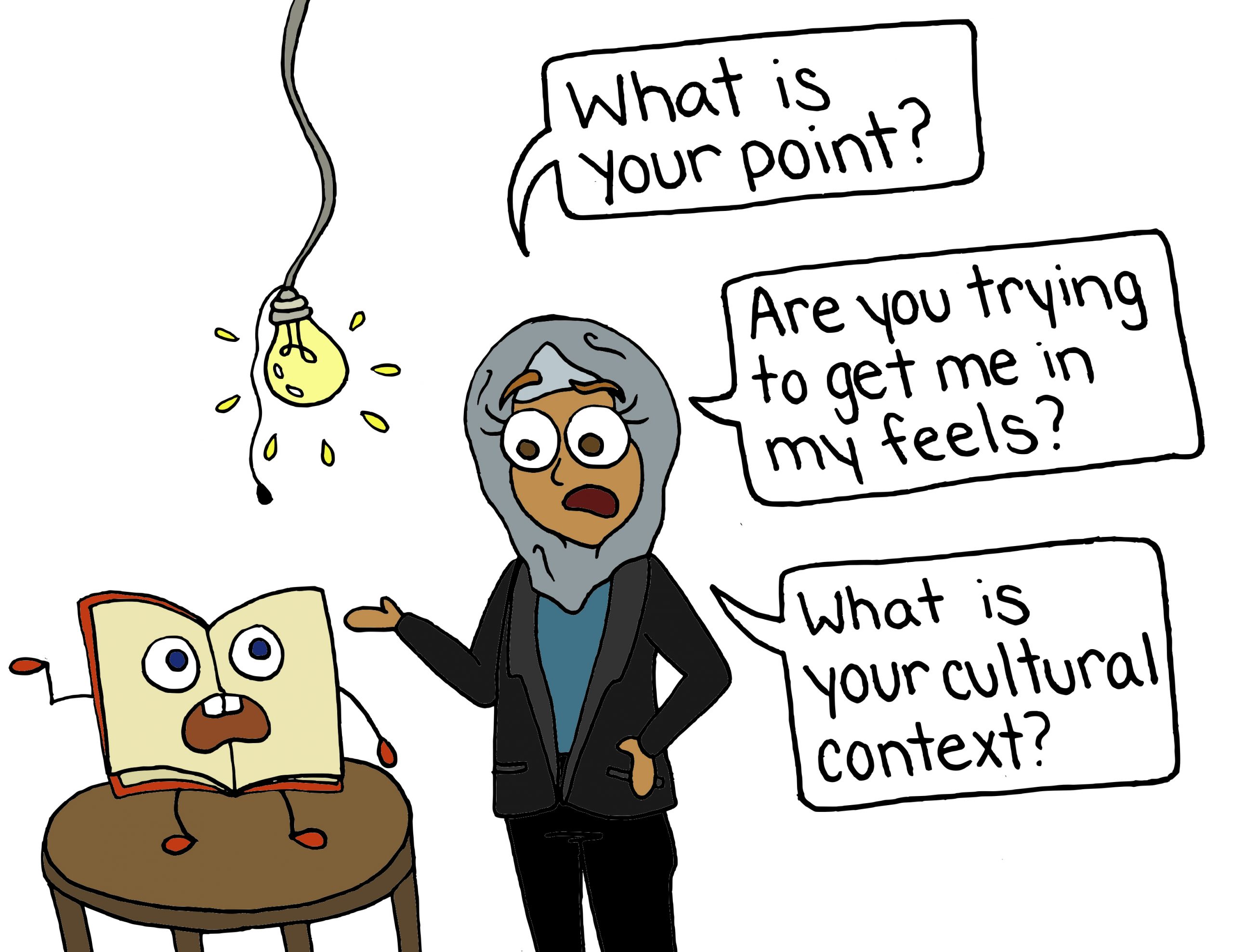20 Critiquing a Text
When you critique a text, you evaluate it, ask it questions. Some people think of critique as being negative or mean, but in the academic sense, doing a critique is not the least bit negative. Rather, it’s a constructive way to explore and understand the material you’re working with. The origin of the word means “to evaluate,” and through your critique, you engage in a deep evaluation of a text: when you critique a text, you interrogate it. Check out Figure 2.7, which illustrates reflective questions that you may ask yourself. For example, sometimes you want to consider the emotional impact of a text on your thinking.

Figure 2.7: Interrogating the text
When you critique, your own opinions and ideas become part of the textual analysis. You question the text, you argue with it, and you delve into it for deeper meanings. To get you started, see Table 2.7 for a few ideas to consider when critiquing a text. When you critique, bring in content from the text (textual evidence) to support your ideas while writing for assignments.
Table 2.7: Critiquing a text
| Item | Link to nursing |
|---|---|
| Main point/summary
Do the authors make their main point successfully? Is the point made consistently throughout the text, or does it wander at any point? What information does the author provide to support the central idea? Making a list of each point will help you analyze. Hint: each paragraph should address one key point, and all paragraphs should relate to the text’s central idea. What kind of evidence does the author use? Is it based more on fact or opinion, and do you feel those choices are effective? Where does this evidence come from? Are the sources credible? Was evidence used correctly, without manipulation? Does the text’s flow make sense? Is the line of reasoning logical? Are there any gaps? Are there any spots where you feel the reasoning is flawed in some way? Are the authors’ statements clear? Is anything confusing? What worked well in the text? What was lacking or failed completely? |
The use of evidence, particularly research evidence, is important in most types of scholarly writing in nursing and other health-related disciplines. Evidence provides support for the claims made in writing. This is important considering that these claims may lead to potential practice and policy changes. Thus, you need to be prepared to evaluate the quality of evidence used. |
|
Tone Describe the tone in the piece. Is the text’s tone and language appropriate? Is it friendly? Authoritative? Does it lecture? Is it sarcastic? Do the authors use simple language, or is it full of jargon? Does the language feel positive or negative? Identify aspects of the text that create the tone; spend some time examining these and considering how and why they work. |
Jargon (e.g., complex medical language) can be quite common in nursing and other health-related disciplines. Critiquing involves evaluating whether the source’s tone is appropriate for the audience. Is the text written for a person with health-related expertise? Is the text written for a student? Is the text written for a client? |
|
Emotion/objectivity Do the authors appeal to your emotions? Do the authors use any controversial words in the headline or the article? Do these affect your reading or your interest? Are the authors objective, or do they try to convince you to have a certain opinion? Why do the authors try to persuade you to adopt this viewpoint? If the authors are biased, does this interfere with the way you read and understand the text? Note that an author may be subjective, or unbiased, or unreasonable! Every type of writing and tone can be used for a specific purpose. By identifying these techniques and considering why the authors are using them, you will begin to understand more about the text. |
The use of emotions and objectivity (or subjectivity) depends on the purpose of the writing. For example, prompting the reader’s emotion may be very important if the authors are writing an editorial for a newspaper about the lack of funding in pediatrics and mental health. On the other hand, an objective viewpoint that highlights the evidence may be important if the authors are writing a policy paper about needed funding in pediatrics for mental health resources. These decisions are often based on the target audience. |
|
Response How did you respond to the piece? Did you like it? Did it appeal to you? Could you identify with it? Do you believe the authors? Do you accept their thoughts and ideas? Why or why not? |
Your response is important to consider in nursing considering that the text’s appeal and believability will influence whether you decide to include a source in your own writing and whether the source’s claim will influence your practice. |
|
Cultural context What is the cultural context* of the text? *Cultural context is a fancy way of asking who is affected by the ideas and who stands to lose or gain if the ideas take place. When you think about this, think of all kinds of social and cultural variables, including age, gender, occupation, education, race, ethnicity, religion, economic status, etc.
|
These social and cultural variables are important in nursing considering the diversity of clients, families, and practitioners. |
Activities: Check Your Understanding
Attribution statement
Content from this page was remixed with our original content, and with editorial and formatting changes, content from this page was adapted from:
The Word on College Reading and Writing by Carol Burnell, Jaime Wood, Monique Babin, Susan Pesznecker, and Nicole Rosevear, licensed under a Creative Commons Attribution-NonCommercial 4.0 International License, except where otherwise noted. Download for free at: https://openoregon.pressbooks.pub/wrd/
Constructive way to explore, interrogate, and evaluate a text.

